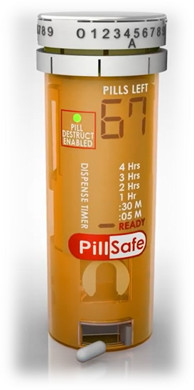
PillSafe Provides a Solution to the Opioid Epidemic's $1 Trillion-Plus Impact on the US Economy
As federal and state governments implement far-ranging programs to address the crisis, PillSafe offers a technology-based solution that ensures patients comply with prescriptions.
EDMOND, OK / ACCESSWIRE / May 14, 2024 / The nation's opioid epidemic costs the U.S. economy more than $1 trillion a year in lost labor hours, productivity, and healthcare costs. The federal and state governments are launching complex and costly programs to address the crisis. Yet, products like the PillSafe bottle, a patented "smart" pill delivery system, offer an efficient, technology-based solution.

Developed by doctors and designed to protect patients, PillSafe uses proprietary technology that distributes the appropriate amount of medication at the time prescribed by the doctor and prevents tampering with the bottle, ensuring compliance with the doctor's prescription.
PillSafe was developed to address an overdose epidemic that has killed more than 100,000 people in the United States every year since 2001 and is the leading killer of people 18 to 49 in the United States. From 2015-2018, the opioid epidemic cost the U.S. economy $2.5 trillion. In 2020 alone, the epidemic imposed a $1.5 trillion burden on the economy, equivalent to 7% of that year's GDP.
"Addressing this crisis requires continued efforts and resources to combat addiction and reduce fatal overdoses. Dollars and education alone will not solve the Opioid challenge. Funding ‘smart' technologies is the next step," said Dr. John Barr, co-founder of PillSafe.
A review of recent legislation and programs from the federal government and several state governments, including New York, Illinois, and Washington, illustrates the extraordinary and expensive efforts dedicated to the opioid crisis.
The U.S. Congress has passed three laws, the Comprehensive Addiction and Recovery Act (CARA), the 21st Century Cures Act, and the SUPPORT for Patients and Communities Act, that will spend more than $10.6 billion by 2028 on programs to decrease the supply and demand for opioids.
The Department of Health and Human Resources (HHS) mentioned in a March 2020 report that $300 million, almost one-third of the State Targeted Response to the Opioid Crisis grant program's $970 million funding, was not spent by some of the states. Another 14 states spent less than half of their funding share. All but six states asked for a 12-month extension.
The federal government's Department of Labor has a program that hires individuals in recovery, providing fidelity bonds for "at-risk" and difficult-to-place job seekers. The bonds cover the first six months of employment at no cost to the job seeker or the employer. Also, New York and Illinois governments have created tax credits to incentivize employers to hire individuals in recovery. The U.S. Chamber of Commerce also promotes resources for second-chance hiring programs.
According to a survey by the National Safety Council, 75% of employers reported that opioid use has impacted their workplace, and only 17% reported being extremely well-prepared to address the issue. An estimated 12.6% of the American workforce receives an opioid prescription today. Workers with substance use disorders take 50% more unscheduled leave and have a turnover rate 44% higher than other people. Workers affected by opioids are also more likely to experience occupational injuries that result in time away from work.
The State Opioid Response grant program has allowed states to provide treatment services to over 1.2 million people in the U.S. since 2018, purchase roughly 10 million overdose reversal medication kits that helped with 550,000 overdoses, and offer funding for access to medications, treatment of opioid use disorder, and increase prevention, harm reduction, treatment, and recovery support services for substance use disorder.
State governments across the country have approved or are planning elaborate programs to address the opioid crisis and its impact on the economy. New York and Illinois have created tax credits to incentivize employers to hire individuals in recovery. In Washington, the governor approved a measure in March to help tribes and indigenous people deal with their soaring overdose death rates. It would provide nearly $8 million annually until at least 2031 for the state's 29 federally recognized tribes.
In Texas, where a study showed that overdoses in 2022 cost the state $114.6 billion in gross product and 1.2 million years of work, the state is expected to spend about $700 million from a settlement with pharmaceutical companies on programs to reduce opioid addiction.
Given the scope of the issue and governments' scattershot response, the PillSafe developers want to announce an open invitation to partner with any State on sharing the licensing revenues from PillSafe technologies in support of their incentive programs on Employment, Compliance, and Recovery. We invite State Representatives to contact the PillSafe team at https://pillsafeprotection.com.
About PillSafe
PillSafe is a pioneering "smart" technology that shifts the standard of care in the pharmaceutical industry with home delivery and patient compliance in response to the opioid epidemic. The company creates prescription compliance by restricting access to medication to only the patient, keeping medication safe from divergence and abuse. PillSafe's "intelligent" design includes several innovative features that benefit the delivery network from the manufacturer to the pharmacy to the patient. The patented technology includes an electronic label that can increase adherence messaging, two-step verification, or active advertising from the manufacturer to the pharmacy to the patient.
In 2022, 27 million Americans had a drug use disorder. The economic impact of opioids has been substantial, affecting lives, families, and the working population directly. A CDC review of mortality data from 21 states reported that unintentional overdose deaths accounted for a disproportionate share of all deaths in six occupational groups: construction, extraction (e.g., mining), food preparation and serving, health care practitioners, health care support, and personal care and service.
Contact Information
Jessica Lombao
Media Advantage Account Manager
jessica.lombao@issuerdirect.com
SOURCE: PillSafe
View the original press release on newswire.com.
Editor Details
-
Company:
- AccessWire
- Website:
